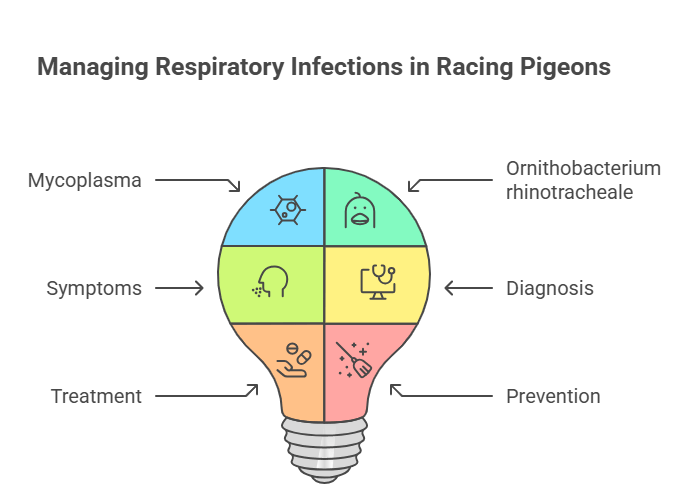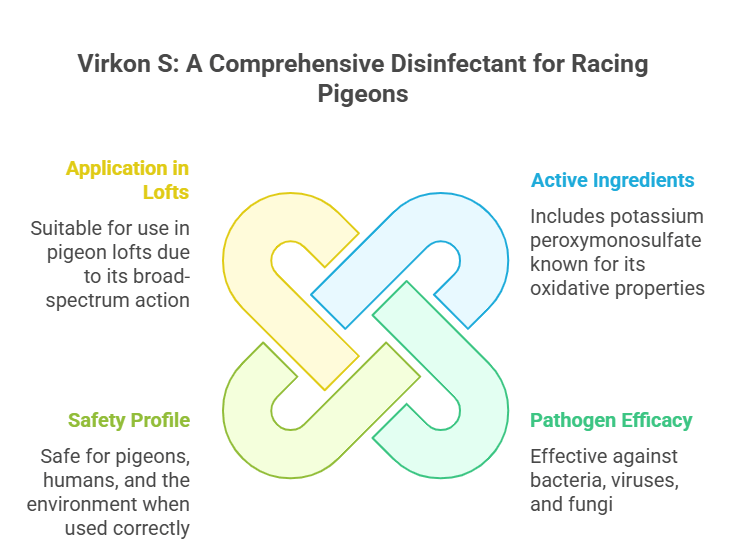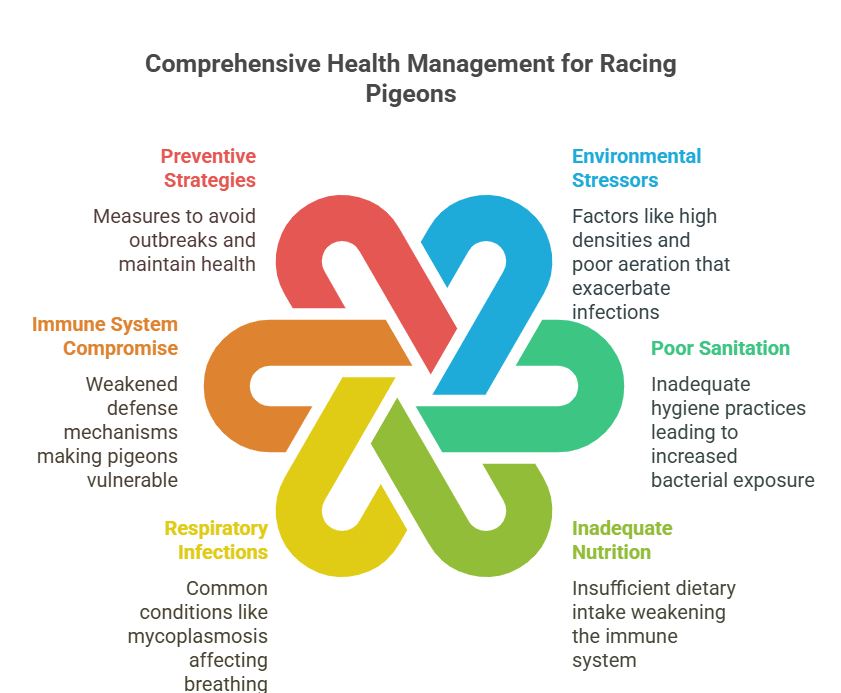Introduction to Racing Pigeons and Their Health
TREAMENTS
Racing pigeons, commonly known for their remarkable ability to navigate long distances, hold a special place in the sport of pigeon racing. These birds are highly trained to return home from various locations, often spanning hundreds of miles, which has made them a popular choice among avicultural enthusiasts and competitive racers alike. Their unique physiology, combined with their exceptional navigational skills, underscores their status as remarkable athletes in the avian world.

In order to perform at their best, racing pigeons require diligent care and management. Optimal health is paramount to ensure their performance capabilities, given the physical demands of racing. Just like any other sports competitors, they may face a variety of health concerns over time. Among these, respiratory diseases stand out as significant challenges that can impact not only their racing abilities but also their overall well-being. These diseases may arise from various factors, including environmental conditions, stress, and inadequate nutrition.
The respiratory system of racing pigeons is intricate and must function effectively to support their high activity levels. Their health can be threatened by exposure to pathogens, allergens, or poor ventilation in their living environments. Symptoms of respiratory disease can manifest in various ways, including coughing, nasal discharge, and lethargy. Monitoring these signs and maintaining a suitable environment can help prevent the onset of respiratory illnesses.
As we delve deeper into the specifics of respiratory issues affecting racing pigeons, it is essential to recognize the significance of holistic health management. Proactive measures, including regular veterinary check-ups and proper environmental care, are crucial for sustaining the health of these remarkable birds and ensuring their performance in racing events.
Common Respiratory Problems in Racing Pigeons
Racing pigeons are subjected to various respiratory diseases that can significantly impact their health and performance. Among the most common conditions is **aspergillosis**, a fungal infection caused by inhaling spores of the Aspergillus fungus, often found in contaminated feed or bedding. Symptoms include coughing, labored breathing, and a decrease in activity levels. If left untreated, this condition can lead to severe respiratory distress, ultimately jeopardizing the pigeon’s ability to race.
Another prevalent issue in racing pigeons is **bacterial respiratory infections**, which can be triggered by several bacteria such as Borrelia or Mycoplasma. These infections manifest through similar symptoms, including nasal discharge, lethargy, and difficulty in breathing. As bacterial infections can spread rapidly in an enclosed environment, it is essential to isolate affected birds to prevent transmission. Affected pigeons may also show a noticeable decline in their racing performance due to compromised lung function.

Environmental factors also play a critical role in the respiratory health of racing pigeons. Dust, ammonia, and other air pollutants can lead to respiratory irritation and chronic respiratory issues. High levels of ammonia, typically arising from poor sanitation in lofts, can cause inflammation of the airways, leading to respiratory discomfort, coughing, and even impaired performance. Regular cleaning and proper ventilation are essential to minimize exposure to these harmful agents.
In summary, common respiratory problems in racing pigeons such as aspergillosis, bacterial infections, and environmental pollutants are serious concerns that can directly influence the birds’ health and competitive capabilities. Recognizing possible symptoms and maintaining a healthy environment are crucial steps in safeguarding these birds and ensuring their racing success.
Preventative Measures and Treatment Options
To ensure the health and longevity of racing pigeons, implementing effective preventative measures against respiratory diseases is crucial. Optimal housing conditions play a significant role in minimizing health risks. Providing a clean, dry loft is essential, as damp and dirty environments can predispose pigeons to respiratory issues. Ensuring that the loft is spacious enough to allow for movement and exercise is also critical in maintaining their overall health.
Ventilation is another vital factor in preventing respiratory problems. Stale air can lead to the accumulation of harmful pathogens, so it is important to provide adequate airflow. Installing proper ventilation systems, including windows or vents, can help maintain fresh air circulation, reducing the chances of respiratory disease outbreaks.

Regular cleaning protocols must also be established. This includes daily removal of droppings and weekly deep cleaning of the loft to eliminate dust and mold that may contribute to respiratory problems. Utilizing safe cleaning agents and ensuring that the loft is thoroughly dried will further enhance the living conditions for racing pigeons.
A well-balanced diet plays an integral role in the prevention of respiratory diseases. Nutritionally adequate feed can boost the immune system, making the pigeons less susceptible to illness. Incorporating supplements, such as vitamins and minerals, may also help strengthen their overall health. Monitoring the pigeons’ weight and performance can aid in ensuring they are thriving on their diet.
In cases where respiratory disease is diagnosed, there are treatment options available. Consulting a veterinarian is essential for proper diagnosis and treatment. Medications may include antibiotics for bacterial infections or antifungals for fungal infections that affect the respiratory system. In certain cases, supportive care such as nebulization or the use of humidifiers may be recommended to alleviate symptoms and promote recovery.
Conclusion and Best Practices for Pigeon Enthusiasts
Ensuring the respiratory health of racing pigeons is critical for their overall well-being and performance. As highlighted throughout this discussion, respiratory diseases can significantly impact the birds’ ability to fly, compete, and ultimately thrive. Prevention and early detection are paramount for pigeon owners who wish to maintain healthy flocks capable of competitive racing.
To minimize the risk of respiratory issues in racing pigeons, owners should prioritize proper housing conditions. This includes ensuring adequate ventilation in lofts to prevent the accumulation of ammonia and dust, which can lead to respiratory complications. Furthermore, maintaining a clean environment by regularly removing waste and providing fresh bedding will contribute to the overall health of the birds.
Nutrition plays a vital role in safeguarding the respiratory systems of racing pigeons. A balanced diet rich in essential vitamins and minerals can help strengthen their immune systems. It is advisable for pigeon enthusiasts to consult with avian nutritionists or veterinarians to formulate diets tailored for their birds based on age, breeding, and activity levels.
Monitoring the health of racing pigeons should be a routine practice. Owners must remain vigilant for any signs of respiratory distress, such as labored breathing, coughing, or nasal discharge. Prompt veterinary consultation is essential if any symptoms arise, as early intervention can often prevent more severe issues from developing.
Additionally, regular health check-ups and vaccinations can further mitigate the risk of respiratory diseases. By investing time in observing and caring for their birds, owners are not only protecting their racing pigeons but also enhancing their competitive edge. In conclusion, adopting best practices in housing, nutrition, and health monitoring will help ensure that racing pigeons remain both healthy and capable of achieving exemplary performance in competitions.

